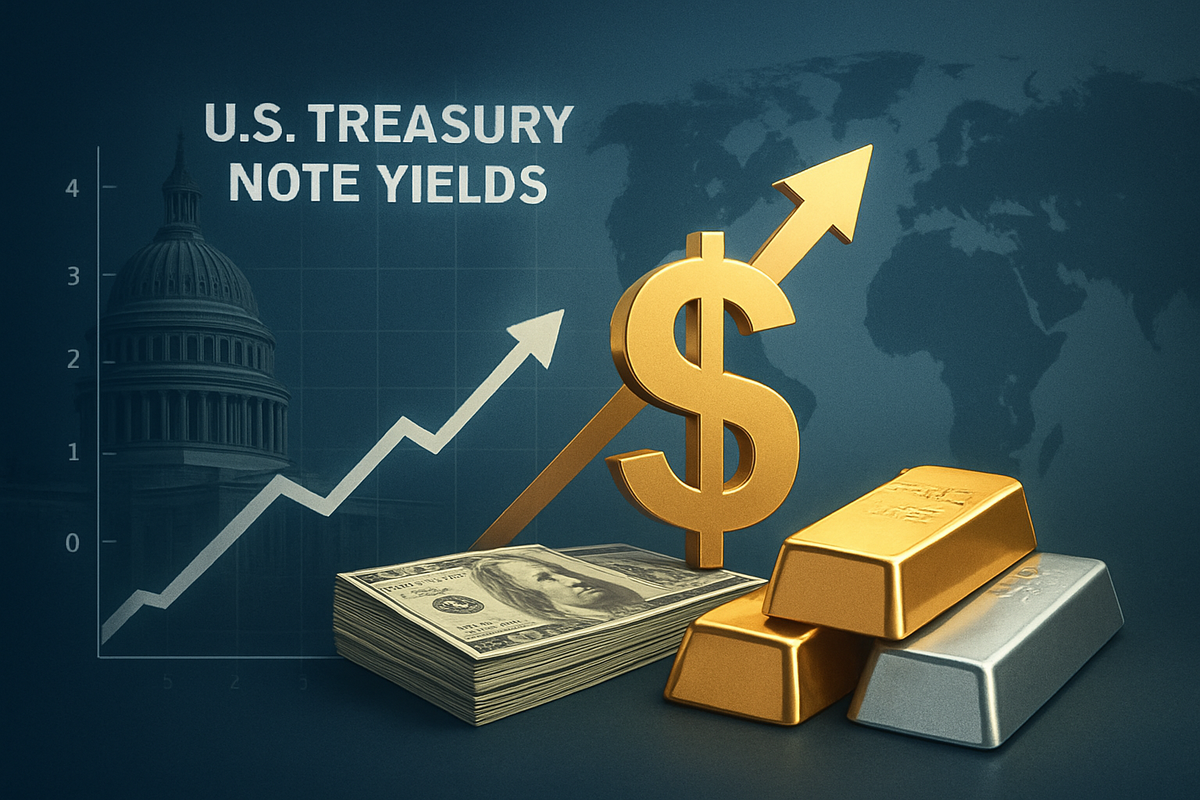Financial News
U.S. Treasury Yields Soar: A Complex Dance for the Dollar, Gold, and Silver

The financial world is currently fixated on the dramatic surge in U.S. Treasury note yields, a development that has sent ripples across global currency and commodity markets. This pronounced upward movement, particularly noticeable from late 2024 and continuing through 2025, represents a significant shift in the fixed-income landscape. While rising yields typically act as a magnet for global capital, bolstering the U.S. dollar, the story for precious metals like gold and silver has been surprisingly counter-intuitive, with both demonstrating remarkable resilience and even significant gains despite the higher cost of holding non-yielding assets.
This surge is reshaping investor strategies and prompting a re-evaluation of traditional market correlations. The implications extend far beyond American shores, influencing economic stability and investment flows across Asia and and Europe, as market participants grapple with a new era of higher borrowing costs and shifting safe-haven narratives.
The Unfolding Yield Narrative: Causes and Initial Market Responses
The recent ascent of U.S. Treasury yields, particularly the benchmark 10-year note, has been a defining characteristic of financial markets throughout 2025, culminating in recent highs as of November 3, 2025. This upward trajectory was notably sharp, with the 10-year yield climbing by 80 basis points over two months in late 2024 and exceeding 100 basis points by January 2025, reaching 4.6% by May and stabilizing around 4.018% by October. This sustained increase has been driven by a confluence of factors, challenging conventional market expectations and creating a dynamic environment for investors.
A primary catalyst for this surge has been the recalibration of Federal Reserve expectations. Initially, markets anticipated a more aggressive rate-cutting cycle from the Fed in 2025. However, the Fed's Summary of Economic Projections (SEP) in September 2024 indicated fewer cuts than expected, and throughout 2025, Chairman Jerome Powell has consistently emphasized that future monetary policy decisions hinge on persistent inflation and the enduring resilience of the U.S. economy. This hawkish stance, coupled with stronger-than-expected economic data—including robust employment figures, strong consumer spending, and rising consumer confidence—has led investors to scale back bets on significant Fed easing, thereby pushing yields higher.
Adding to the upward pressure are growing concerns over U.S. fiscal health. Projections for ballooning national deficits and an expanding national debt have prompted investors to demand a higher term premium—greater compensation for holding longer-dated Treasuries. This fiscal anxiety was exacerbated by a significant tax-cut and spending bill in May 2025, projected to add trillions to the national debt. Doubts about the long-term status of Treasury securities as the pre-eminent global safe-haven asset, partially due to these large deficits, have further contributed to this demand for higher yields. Furthermore, a government shutdown commencing October 1, 2025, has introduced additional uncertainty, delaying crucial economic data and fueling market apprehension. Competition from large corporate bond offerings, such as those from tech giants like Meta Platforms (NASDAQ: META) and Alphabet (NASDAQ: GOOGL), has also diverted investor capital, indirectly adding to the pressure on Treasury yields.
The immediate market reactions have been multifaceted. While rising yields typically strengthen the U.S. dollar by attracting foreign capital seeking higher returns, the dollar's performance has been complex. In some instances, particularly during periods of heightened fiscal concern, the dollar has shown weakness, with the U.S. Dollar Index (DXY) experiencing a downtrend resuming in September 2025. However, the overall trend has seen the dollar generally bolstered by the yield advantage. For gold and silver, the narrative has defied traditional expectations. Despite higher yields, both precious metals have not been pressured but have instead surged. Gold reached a record high of over $3,500 per ounce by September 2025 and surpassed $2,700 per troy ounce in October, while spot silver rose 36% year-over-year to over $39 per ounce by July, its highest since 2011. This unexpected rally is largely attributed to their role as safe havens amidst geopolitical risks, global economic uncertainty, and persistent inflation concerns, coupled with strong central bank buying and robust industrial demand for silver.
Companies Navigating the High-Yield Environment
The surge in U.S. Treasury yields and the subsequent market dynamics create a distinct landscape of winners and losers among public companies, particularly those with significant exposure to interest rates, currency fluctuations, and commodity markets.
Potential Winners:
Financial institutions, especially banks, often stand to benefit from a rising interest rate environment. Higher yields typically translate to improved net interest margins (NIMs), as banks can charge more for loans while the cost of deposits may lag. Major U.S. banks like JPMorgan Chase & Co. (NYSE: JPM), Bank of America Corp. (NYSE: BAC), and Wells Fargo & Co. (NYSE: WFC) could see increased profitability from their lending activities. Investment banks and asset managers that deal in fixed-income products might also see increased trading volumes and fees as investors adjust their portfolios to the new yield environment. Companies with strong balance sheets and low debt levels are also better positioned, as their borrowing costs remain manageable compared to highly leveraged counterparts.
Furthermore, companies that generate substantial revenue in foreign currencies but incur costs in a strengthening U.S. dollar might see their dollar-denominated profits improve. However, given the nuanced performance of the dollar, this benefit is not uniform. Companies involved in the precious metals sector, specifically gold and silver miners, have been significant beneficiaries. Companies like Barrick Gold Corp. (NYSE: GOLD), Newmont Corp. (NYSE: NEM), and Wheaton Precious Metals Corp. (NYSE: WPM) have seen their stock prices supported by the surge in gold and silver prices. The increased value of their underlying commodities directly boosts their revenue and profitability, even as their operational costs might face some inflationary pressures.
Potential Losers:
Conversely, companies heavily reliant on debt financing or those with significant capital expenditure plans are likely to face increased borrowing costs. Industries such as real estate, utilities, and highly leveraged growth companies, particularly in technology, could see their expansion plans constrained and their profitability eroded by higher interest payments. For instance, real estate investment trusts (REITs) like Prologis Inc. (NYSE: PLG) or American Tower Corp. (NYSE: AMT), which often carry substantial debt to finance property acquisitions, may find their cost of capital rising significantly.
Export-oriented companies, especially those with substantial international sales, could face headwinds from a stronger U.S. dollar. A stronger dollar makes U.S. goods more expensive for foreign buyers, potentially reducing demand and cutting into profit margins. Large multinational corporations like Apple Inc. (NASDAQ: AAPL) or Boeing Co. (NYSE: BA), while diversified, could experience some negative currency translation effects on their overseas earnings. Additionally, companies in sectors sensitive to consumer discretionary spending might suffer if higher interest rates lead to a slowdown in economic activity or reduce consumers' purchasing power due to increased mortgage or loan payments. The automotive industry, with companies like General Motors Co. (NYSE: GM) and Ford Motor Co. (NYSE: F), could see a decrease in vehicle sales as financing costs for consumers rise.
Broader Implications for Global Markets
The sustained surge in U.S. Treasury yields carries profound implications that extend well beyond American borders, fundamentally reshaping global currency and commodity markets, particularly in Asia and Europe. This development fits into a broader trend of central banks worldwide grappling with persistent inflation and the winding down of ultra-loose monetary policies, even as the U.S. Federal Reserve charts its own course.
For global currency markets, the primary ripple effect is the complex interplay with the U.S. dollar. While higher U.S. yields typically attract capital, strengthening the dollar, the current environment has shown nuances. However, generally, a stronger dollar can put pressure on other currencies, especially those in emerging markets (EMs). Asian economies, heavily reliant on dollar-denominated trade and debt, face increased costs for servicing their foreign debt and importing essential goods. Currencies like the Japanese Yen (JPY) and the Korean Won (KRW) could weaken further against the dollar, potentially leading to inflationary pressures through more expensive imports. European economies also feel the impact, with the Euro (EUR) potentially depreciating against a relatively stronger dollar, affecting the competitiveness of European exports and import costs. This dynamic can force central banks in these regions to consider their own monetary policy responses, potentially leading to rate hikes to defend their currencies, even if their domestic economic conditions don't fully warrant such tightening.
In commodity markets, the traditional inverse relationship between yields and precious metals has been challenged. The resilience and surge in gold and silver prices, despite higher U.S. yields, indicate a deeper underlying concern among investors about global economic stability, geopolitical risks, and persistent inflation. This suggests a flight to safety and a hedge against currency debasement, rather than a simple yield play. This trend could encourage other central banks to continue diversifying their reserves away from the dollar and into gold, as seen with record central bank gold purchases. For industrial commodities, higher U.S. interest rates can signal a potential slowdown in global growth, which might temper demand. However, specific commodities like silver, with its significant industrial applications in green technologies, could continue to see robust demand, creating a divergence in performance.
Historically, periods of rising U.S. yields have often preceded or coincided with financial stress in other parts of the world, particularly in emerging markets, due to capital outflows. The current situation echoes some of these historical precedents, such as the "Taper Tantrum" of 2013, where even the talk of Fed tapering led to significant market volatility and capital flight from EMs. The current environment, with actual sustained yield increases, poses a more significant and prolonged challenge. Regulatory bodies and policymakers globally are closely monitoring these developments, potentially considering macroprudential measures to stabilize financial systems and manage currency volatility. The fiscal policies of major economies, particularly the U.S., are under increased scrutiny, as large deficits contribute to yield pressure and raise questions about long-term debt sustainability, influencing global investor confidence.
What Comes Next: Navigating the Shifting Sands
The current trajectory of U.S. Treasury yields and its multifaceted impact suggest a period of continued volatility and strategic re-evaluation for global financial markets. In the short term, investors should anticipate ongoing sensitivity to U.S. economic data, Federal Reserve communications, and geopolitical developments. Any signs of persistent inflation or further economic resilience could push yields even higher, reinforcing the dollar's strength (or its complex, nuanced path) and potentially exacerbating pressures on certain sectors and regions. Conversely, unexpected economic weakness or a more dovish shift from the Fed could lead to a temporary pullback in yields, offering some respite to debt-laden entities and potentially weakening the dollar.
Longer term, the sustained higher-yield environment could necessitate significant strategic pivots across industries. Companies with substantial debt will be compelled to prioritize debt reduction and more conservative capital management strategies. Industries like technology and real estate, which thrived on cheap capital, may need to innovate more efficiently and focus on organic growth rather than debt-fueled expansion. Multinational corporations will need to enhance their currency hedging strategies to mitigate the impact of dollar fluctuations on their international earnings.
Emerging market economies and their central banks face the ongoing challenge of balancing domestic growth with currency stability. They may need to consider further interest rate hikes to defend their currencies and stem capital outflows, even if it risks stifling local economic activity. This could lead to a divergence in global growth trajectories, with some regions struggling under the weight of higher borrowing costs.
Market opportunities may emerge for investors who can identify companies resilient to higher rates or those that benefit from the new market dynamics. Value stocks, particularly those with strong cash flows and lower debt, might outperform growth stocks. In the commodity space, the unique resilience of gold and silver suggests they could continue to serve as important portfolio diversifiers and hedges against broader market uncertainties, even if their traditional inverse correlation with yields remains challenged. Furthermore, industries that benefit from a stronger dollar (if that trend solidifies) or those with strong pricing power to pass on increased costs could present attractive investment opportunities.
Potential scenarios range from a gradual normalization of yields, where markets adapt to a moderately higher rate environment, to more disruptive outcomes if fiscal concerns escalate or if global economic growth falters significantly. A "hard landing" for the U.S. economy, while not currently the base case, could trigger a sharp flight to quality, potentially reversing some of the current trends. Conversely, a sustained period of robust U.S. growth, coupled with persistent inflation, could solidify the higher yield environment for an extended period, forcing a more profound recalibration of global asset prices and capital flows.
A New Chapter for Global Finance
The recent surge in U.S. Treasury note yields marks a pivotal moment for global financial markets, signaling a potential shift into a new chapter defined by higher interest rates and complex market dynamics. The key takeaway from this period is the breakdown of some traditional correlations: while the U.S. dollar has generally been bolstered by the yield advantage, its path has been nuanced, and precious metals like gold and silver have defied expectations, surging as safe havens amidst broader uncertainties rather than being pressured by rising yields.
Moving forward, the market will continue to be driven by a delicate balance of factors: the Federal Reserve's monetary policy decisions, the trajectory of U.S. economic data, the evolving fiscal health of the U.S. government, and the ever-present geopolitical landscape. Investors must remain agile, recognizing that the "easy money" era is likely behind us, and a more discerning approach to asset allocation and risk management is paramount.
The lasting impact of this yield surge will likely be a recalibration of global capital flows, a re-evaluation of sovereign debt sustainability, and a renewed focus on corporate balance sheet strength. What investors should watch for in the coming months are further indications from the Federal Reserve regarding its rate path, any significant shifts in U.S. fiscal policy, and the resilience of global economies in adapting to a higher cost of capital. The performance of the U.S. dollar, gold, and silver will continue to be key indicators of underlying market sentiment and the broader health of the global financial system.
This content is intended for informational purposes only and is not financial advice
More News
View More



Recent Quotes
View More
Quotes delayed at least 20 minutes.
By accessing this page, you agree to the Privacy Policy and Terms Of Service.



